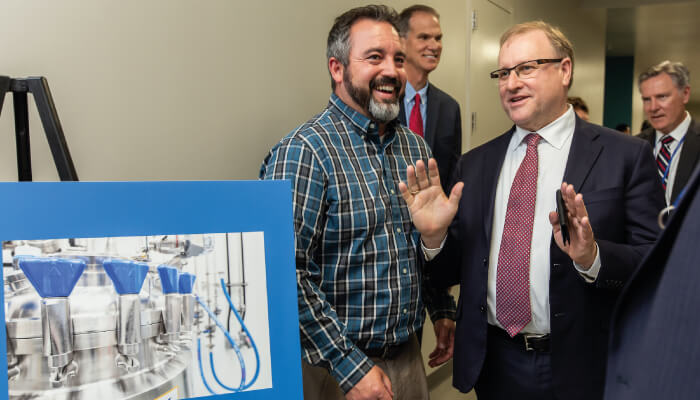This article is part of our special focus on "traditional" pharma: The Small Molecule Manufacturer (read more here). You can find more articles from The Small Manufacturer here.

Innovation is in our DNA at Agilent – and that philosophy must extend beyond the R&D community. Yes, we must develop products at the cutting edge for our customers, but we must also be innovative when it comes to how we work with our customers – and how we run internal operations. It’s easy to talk about these things – but do you actually run the business this way?
When I first took on this role in 2015, I discussed profitability goals with the investment community, as you might expect. “Well, Mike,” they said. “Why not just cut your R&D budget in half, and you’ll reach your goals much faster…”
“That would destroy who we are,” I replied. “We are an innovation driven company.” And that’s why we are willing to invest such a high percentage of our revenue into R&D – over $1 billion in the next three years. We’re also the only company in our space with a long-term basic research effort – Agilent Labs, staffed with world-class scientists developing the technologies of the future.

Consider your smartphone – you’re probably less interested in the underlying technology than the experience it enables. When it comes to analytical technology, while yesteryear’s users may have built their own instrumentation, today’s users simply want to ensure that it meets their workflow needs. Our technology is trending towards smaller, faster, easier to use, and better integrated – back to my analogy: everyone now has a far more powerful computer in their pocket than the one I had on my desk when I started at Hewlett-Packard...
I can’t remember ever looking that far ahead! And, in fact, when I dispense career advice, my first pearl is: “Don’t over manage your career – because you never really know where it will take you.” My second piece of advice: “Always follow the experience and accept opportunities to learn.”
When I finished my MBA at The Wharton School at the University of Pennsylvania in the 1980s, the next step should have been Wall Street. And though I had job offers on the table from investment banks, I recognized that I really didn’t want to enter that world.
I wanted to work for a company with a mission – a company that developed and created a tangible product. At Hewlett-Packard, I knew that my ability to progress was only linked to my willingness to develop myself and take a few personal risks. I entered the company as a financial analyst, so perhaps dreamed of becoming the Chief Financial Officer one day… But as I moved through my career, I learned that I had inherent leadership qualities.
Over time, I built up a track record of growing businesses and turning businesses around. When we created the new Agilent in 2015, I was asked to become the third CEO. Notably, my predecessors were both R&D engineers. And that links to another piece of advice: “Don’t allow people to put you in a box or tell you what you can’t do.”
Easy: when we received the results of one of our leadership surveys – about three years into our journey. Every six months, we ask all 16,000 Agilent employees how we’re doing. We recruit an external consultancy team to analyze the results and compare us with the best out there. Our scores for employee engagement had grown significantly over that relatively short period; apparently, we were “best in class.” It’s great to make investors happy with rising stock prices, and to see customers reacting more positively to their experience with us. But I am most proud and satisfied by how our employees feel about working at Agilent – because that’s really how we’ve achieved our other goals. There’s plenty of information out there pointing to the fact that companies with highly engaged workforces do well. And it was great to have proof that I wasn’t just being a delusional CEO...
First of all, the pharmaceutical market is the largest market for Agilent, at over 30 percent of our revenue. We have been working hard to become a broader supplier to customers in that market. Recently, I was with the investment community in London and everyone wanted to talk about biopharma, which is very exciting and has high growth rates – and, of course, Agilent has solutions in that space. But I’m always very quick to remind people that small molecule pharma is not going away – and it is being driven by the need to lower costs across the world. And that means the industry needs new tools that allow them to do more with less, or to be more efficient in QA/QC, for example.
But supplying the right tools is only one part of the solution. My fundamental business strategy for Agilent was not only to help our customers do great science, but also to help them with the operations and economics of the lab. And so, in addition to easier to use, digitally-integrated solutions with smaller footprints, such as the Ultivo triple quadrupole LC/MS system, we’ve got a whole series of new capabilities for laboratory managers; for example, the potential to monitor instrument utilization and peak run times, to provide troubled asset reports, and so on. Rather than supplying a pinpoint product to an analytical lab, we look at the whole ecosystem – and consider how we can not only integrate into it but also add real value.




